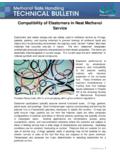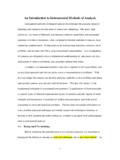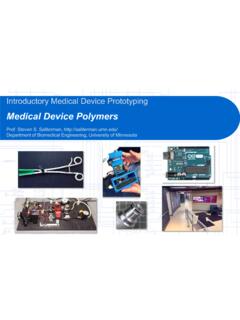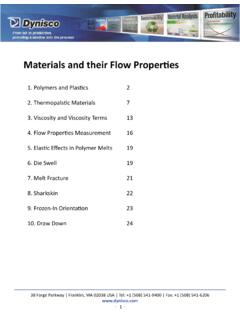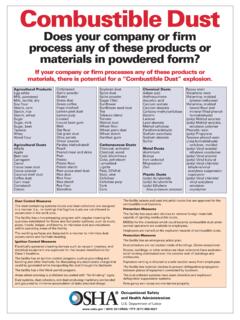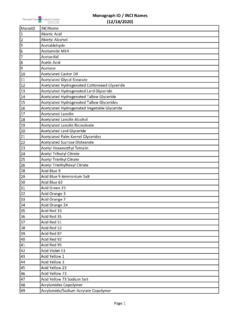Transcription of Elastomer Types and Chemical Compatibility
1 Elastomer Types and Chemical Types and properties Elastomer Chemical compatibilityElastomer Seal Selection Criteria3830 Novotema is a world-class designer and manufacturer of technical components and Elastomer sealing solutions for demanding over 300 Elastomer (rubber) material grades to choose from, Novotema is sure to have a sealing material to suit any guide details the generic Chemical resistance of 15 different Types of Elastomer material, tested in ambient (room temperature) operating temperatures accelerate the speed at which Chemical degradation of Elastomer seals occurs. Seek advice from your seal provider, for clarification of material suitability for your Types and propertiesElastomer Types are often referred to under standard designations/acronyms listed in ASTM D1418 or ISO 1629.
2 A brief description of each Elastomer type and their typical characteristics follows:CR (Chloroprene) Chloroprene rubbers are essentially chlorinated polyisoprenes, which exhibit medium resistance to high molecular weight oils. Chloroprene rubbers contain chlorine in the polymer to reduce the reactivity to many oxidising agents, as well as to oil and flame. CR elastomers also have good resistance to ozone cracking, heat ageing and Chemical attack. Some of the important applications of CR elastomers include Vee-belts, coated fabrics, cable jackets, tyre-sidewalls, seals and gaskets in contact with refrigerants, mild chemicals and atmospheric (Chlorosulphonylpolyethylene or Chlorosulphonatedpolyethylene) CSM grades contain 24-43% chlorine content to provide excellent ozone and weather resistance, high resistance to many oxidising and corrosive chemicals, good resistance to dry heat to 150 C/302 F, low flammability and gas permeability, and also good resistance to hot water (when cured with lead oxide).
3 The low temperature properties are generally limited, depending on the chlorine content of the CSM grade used, and the compression set is not very good. CSM elastomers are generally useful in electrical applications, weather resistant membranes, hoses and acid resistant tank (Epichlorohydrin) These halogenated linear aliphatic polyethers show excellent resistance to ozone and weathering and very good resistance to hydrocarbon oils bettered only by polysulphides, fluoroelastomers and high-acrylonitrile nitrile rubbers. They exhibit good mechanical properties but are susceptible to sour gas attack. They are unsuitable for use with ketones and esters, alcohols, phosphate ester hydraulic fluids, sour gas, water and steam, and generally not recommended for rubber to metal bonding (they are corrosive to metals).
4 The main applications for ECO elastomers are centred on the automotive industry, for use as seals, gaskets, diaphragms, cable jackets, belting, plus low temperature Natural Gas (Polyacrylic or Polyacrylate) These rubbers are usually copolymers of ethyl acrylate and a vinyl ether and are resistant to heat, hydrocarbon oils and in particular, oil additives, especially sulphurised Types used for lubrication under extreme pressure elastomers offer excellent heat resistance; they can typically be used at temperatures of 150 C/302 F (up to 175 C/347 F for limited periods). They provide high resistance to ozone, weathering and oxidation but are extremely susceptible to hydrolysis, hence their unsuitability for use in aqueous media.
5 Compression set and low temperature flexibility depends on the base polymer and compounding choice. ACM elastomers are used primarily where combined resistance to heat and oil is required, typical uses include O-rings, seals and gaskets mainly for the automotive industry, particularly under-bonnet (Ethylene Acrylic) These elastomers are terpolymers of ethylene, methyl acrylate and a cure site monomer. AEM elastomers offer good resistance to heat ageing, weathering, aliphatic hydrocarbons and good low temperature performance. They show poor resistance to strong acids, hydrolyzing agents and some polar fluids. AEM applications are similar to those of ACM elastomers, but AEM has the advantage where low temperature flexibility is concerned.
6 Applications typically include shaft seals, spark plug boots, CV joint bellows and ignition wire / EU (Polyester and Polyether Urethane) These elastomers generally show outstanding tensile strength, tear and abrasion resistance, and give excellent protection against oxygen and ozone (except in hot climates, due to greater risk of microbiological attack in AU Types , and ultraviolet light in the case of EU Types ). EU elastomers have a better low temperature flexibility (-35 C/-31 F typically) and both have excellent resistance to high-energy radiation. Polyurethane rubbers are used where high abrasion resistance and oil / solvent resistance are required together, hydraulic seals and gaskets, diaphragms, hoses and roller-skate and skateboard wheels.
7 In all applications, consideration should be given to hydrolysis and limited heat (Ethylene-Propylene) These rubbers are mainly available in two structures as the copolymer (EPR), or as the terpolymer (EPDM). The properties for both Types of rubber are very similar with the polymers exhibiting outstanding resistance to weathering, ozone, water and steam. These rubbers have good Chemical resistance and are particularly recommended for use with phosphate ester based hydraulic systems. They are typically used in the production of window and door seals, wire and cable insulations, waterproofing sheets and hoses. They are not suitable for use with mineral oils or petroleum based fluids. These rubbers can either be sulphur or peroxide-cured, in general sulphur-cured grades have superior mechanical properties and inferior high temperature properties and vice-versa for peroxide cured (Fluoroethylene Propylene-Perfluoroalkoxy) These chemically modified fluorocarbon copolymers (fluoropolymers) appear more like plastic than rubber, they are extremely resilient and show excellent Chemical resistance.
8 Mechanical properties are very good even at high temperatures. Non-stick characteristics are excellent and abrasion resistance can be classified as moderate. The effective continuous temperature range is from -100 C/-148 F to +200/250 C/ +392/482 F for FEP/PFA respectively. Typical applications include door seals and sealing systems in diaphragm pumps, cryogenic plants, sealed filter units, corrosive fluid plants, relief and emergency valves and pneumatics. Fluoropolymers are often used to encapsulate other elastomers to produce composite or TFE/P (Tetrafluoroethylene/Propylene) A copolymer of tetrafluoroethylene and propylene, FEPM is solely produced by the Asahi Glass Company, and sold under the name Aflas . FEPM vulcanisates exhibit similar thermal stability to FKM elastomers, but better electrical resistance and a different Chemical resistance profile.
9 FEPM compounds have the ability to resist a wide range of Chemical combinations such as sour gas and oil, acids and strong alkalis, ozone and weather, steam and water, all hydraulic and brake fluids, alcohols, amine corrosion inhibitors, water-based drilling and completion fluids, high pH completion fluids and high energy radiation. However, they are not compatible with aromatic hydrocarbons, chlorinated hydrocarbons ( and acetone), organic acetates and organic refrigerants. FEPM elastomers are suitable for long-term service in air up to 225 C/437 F and for short periods up to 250 C/482 F, but are limited in low temperature applications. They are finding wide applications mainly in oil-field operations and Chemical processing as O-rings, seals and gaskets, cable insulating and jacketing and hose (Perfluoroelastomer) FFKMs exhibit outstanding high temperature properties and are the most chemically resistant Elastomer available; effectively a rubber form of PTFE.
10 They are superior to FKM elastomers, showing continuous dry-heat resistance to 260 C/500 F, with extended performance to 330 C/626 F for high temperature grades. They are extremely inert chemically and show excellent resistance to the majority of chemicals that attack other elastomers. Other notable properties include excellent resistance to oil-well sour gases, high temperature steam, low out-gassing under vacuum and good long-term high temperature compression set resistance. Typical applications are sealing systems for oil refineries, pharmaceutical plant, aerospace, Chemical plant and the semiconductor industry. FKM/FPM (Fluoroelastomer or Fluorocarbon) This class of rubber is available as a copolymer , terpolymer or tetrapolymer; the type determines the fluorine content and thus, Chemical resistance.
